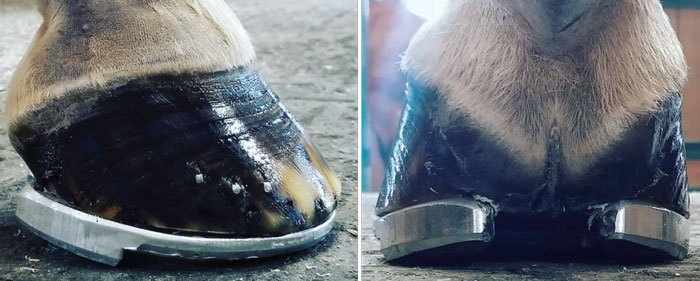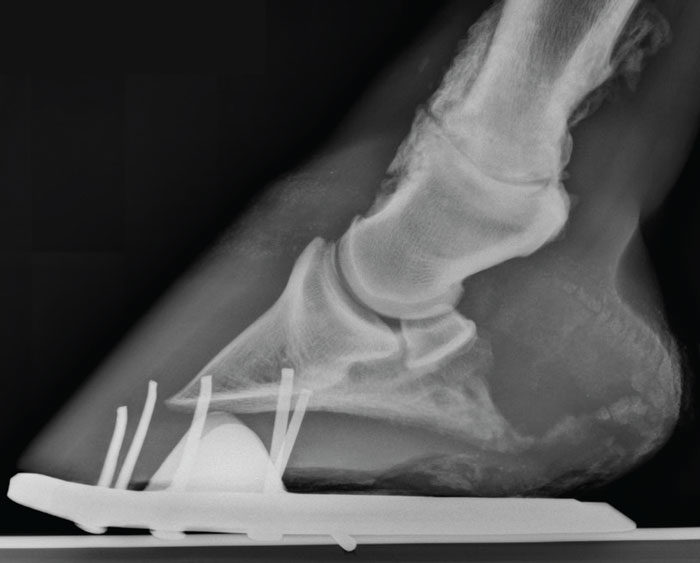If you’ve suffered from a bone spur, you can imagine how ringbone feels to a horse. Some level of discomfort accompanies each step. Swelling might or might not be present, but one thing is for sure, the bony growth interferes with mobility. The same is true for horses.
Ringbone is an old term for degenerative joint disease because it describes the ring of bone spurs and osteophytes around the joints. These bony growths — in the pastern joint for high ringbone and the coffin joint for low ringbone — are the horse’s attempt to stabilize joints and decrease motion, which is secondary to inflammation occurring in the area, explains Julie McGhee Settlage, DVM, DACVS (LA), an equine professional services veterinarian for Boehringer Ingelheim Animal Health.
“Most people think about ringbone as the end stage when the area is ossified and you can see hard bulges through the skin,” says Travis Burns, MSc, CJF (TE, EE), FWCF, associate professor of practice and chief of farrier services at Virginia-Maryland College of Veterinary Medicine. “But I think we often see ringbone in its early stages and at various stages of progression.”
Often, farriers will hear owners say their horse is “not right” — it might occasionally stumble or feel a little off going to the left or the right. Owners may also comment that something is wrong with their horse’s shoulder. But, it’s more common to have issues within the distal limb.
The earliest stages of ringbone can be difficult to diagnose because the symptoms — lameness, decreased performance and resistance to work — can indicate various issues.
“Oftentimes, when a horse is in the early stages of ringbone and a veterinarian uses a palmar nerve block as part of their diagnostic panel, the horse goes sound after blocking,” Settlage explains. “We might delay catching ringbone early because we assume it is something else like navicular and treat the caudal heel pain as if it were navicular to see if that fixes it and then do more investigation down the line.”
“An MRI can pick up the soft tissues in the joint,” Settlage says, “but where I practiced in southwest Virginia, owners rarely go this route because of the cost.”
It's ideal to diagnose ringbone as soon as possible. It is progressive and can be frustrating for horse owners, farriers and veterinarians alike because it can’t be stopped. Eventually, without surgery, it has the potential to be career-ending.
A Joint Effort
Effectively diagnosing and treating ringbone relies on a partnership between farriers and veterinarians working on the horse. It requires the combined expertise of both professionals, access to diagnostic tools, and a treatment strategy that includes a combination of trimming, shoeing and medical treatment.
“Treating a horse with ringbone is an exercise in futility if it’s not being done as a team,” Burns says. “As a team, not only can you work on the mechanics of the horse’s hoof, but with the vet involved, they can do a lot with medical therapies that can either slow the degenerative process or treat the associated pain.
“From the farrier’s standpoint, the treatment is to make it as easy as possible for the horse to break over and turn in all different directions through trimming and shoeing,” he continues. “So, you’ll need to use toe modifications, whether that’s rocker toes, rolled toes, omni-directional shoes, shoes with rolled edges all the way around, to make it easy for the horse to turn in all different directions.”
Horses with ringbone also appreciate modifications that provide cushion or shock dissipation. Burns has seen horses respond well to shock with a variety of pads, including ShockTamer pads, rim pads and leather pads. Some horses will handle and tolerate packing material, while others resent it.
Takeaways
- The ideal time to diagnose ringbone is as soon as possible. It is progressive and can be frustrating for horse owners, farriers, and veterinarians alike because it can’t be stopped.
- The earliest stages of ringbone can be difficult to diagnose because the symptoms — lameness, decreased performance, and resistance to work — can indicate various issues.
- Getting a clear picture of joint changes is complicated. It's difficult to pinpoint early ossification.
Joint injections are commonly part of the ringbone treatment plan to quiet inflammation and help keep the horse comfortable. The injection of choice is influenced by where a veterinarian went to school, completed their internship and residency where they worked their first few years out of school and what is readily available at their clinic, Settlage says.
“Some veterinarians choose a favorite orthobiologic; others use steroids or hyaluronic acid (HA),” she says. “The most productive anti-inflammatory we can use in joints is steroids. If we can get rid of the inflammation with steroids and support the joint with orthobiologics, we can trick the joint into thinking it is in homeostasis to slow down degeneration.”
In 2020, Frontiers in Veterinary Science published A Survey of Clinical Usage of Non-steroidal Intra-Articular Therapeutics by Equine Practitioners, which surveyed 473 equine practitioners about the frequency of non-steroidal treatments for joint injections.
“The number one and two choices for veterinarians remains steroids and HA,” she adds, “but a lot eventually end up pairing that with an orthobiologic to keep this pain as minimal as possible.”
In addition to joint injections, veterinarians often prescribe additional treatment modalities, such as pulsed electromagnetic field therapy. Shockwave therapy has been shown to have an analgesic effect and a positive influence on inflammation in general. However, no specific research has been conducted on its treatment of ringbone, Settlage says.
When farriery, joint injections and other treatments fail to control inflammation or the lameness associated with ringbone, surgery is used to fuse the joint, eliminating the source of the pain. The existing degeneration can’t be reversed. Instead, the goal is to eliminate the source of pain — motion in the joint.
However, there is a catch. Surgery is only an option for high ringbone. While low ringbone is far less common, it is not a candidate for surgery. During the surgical procedure the remaining cartilage in the pastern joint is removed, fusing the joint into correct alignment and is then stabilized with screws or a combination of plates and screws, Settlage explains.

Toe modifications such as omni-directional shoes (above), rocker toes, rolled toes, and shoes with rolled edges all the way around, make it easy for the horse to turn in different directions, Travis Burns says. Photo by: Travis Burns
“Post-surgery we treat the now-fused joint like healing fracture,” she says. “Once fully healed, the first and second phalanx are fused — no joint exists — thus eliminating the prior source of pain. If complications are avoided during the post-operative healing, the horse will no longer experience pain associated with high ringbone.”
Settlage has seen some veterinarians remove some of the palmar digital nerve, or “nerve the horse,” in an attempt to desensitize the foot, and hopefully relieve the horse of the source of pain associated with low ringbone. This is rarely successful long term. Nerving the horse does not de-nerve the coffin joint. It is this joint — not just the back of the foot — that is the source of pain.
“Hopefully, that’s not being reached for much at all, but if the blocking pattern is being interpreted as caudal heel pain, that might be something that happens,” she says. “Then ringbone comes surging forward as a diagnosis as that disease progresses and radiographic changes become more obvious down the line. But removing that piece of the palmar digital nerve won’t fix ringbone.”
Post-Surgery Partnership
Burns and Settlage agree that while farriers and veterinarians must work together at the earliest signs of ringbone, a partnership is even more essential post-surgery to ensure the digit mechanics are not causing stresses to the joint.
“Once the joint becomes abnormal, even normal stresses the horse puts on the joint are amplified,” Burns says. “We have to make sure the horse is balanced to prevent disease advancement.”
Surgery is an expensive endeavor and the choice to move forward often depends on how aggressive the horse owner chooses to be with treatment. Once the pastern is fused, a horse might be able to return to its previous career with appropriate trimming and shoeing. However, not all horses can perform at their previous level.
Learn More Online
Gain more insight about ringbone by reading:
- Diagnosing and Treating Ringbone, in which Dr. Ronald Riegel writes that early diagnosis and treatment are essential for any degree of success.
- Tackling Ringbone, in which Miranda Paton details the case history of a 3-year management program for an older horse with ringbone.
- Benefits of the Omni-Directional Horseshoe, in which Laura Gillespie and Mike Hayward explain various methods for recreating the effects of this appliance.
“People don’t want to hear that they need to lower the expectations of their horse,” Settlage says. “But in some cases, they might have to. The horse may not be able to compete at the top of its discipline but can succeed in lower-level competitions or lesson programs.”
Causes of Ringbone
Researchers don’t have a thorough understanding of what causes ringbone. The sporadic incidence of the disease could make one wonder if it’s genetic, but it doesn’t appear to be associated with familial lines, according to Settlage. When she was in practice, she anecdotally saw more Quarter Horse and Appaloosa horses with ringbone than other diseases, but there is no statistical evidence this is the case.
“Ringbone is probably the result of a combination of factors ranging from abnormal conformation, injury to the joints or their supporting structures, to possibly a sequela when a horse chronically carries its body weight abnormally due to pain elsewhere,” she says. “Great, long-term partnership between a farrier and a veterinarian can go a long way toward slowing down and possibly even preventing chronic joint issues in horses.”









Post a comment
Report Abusive Comment